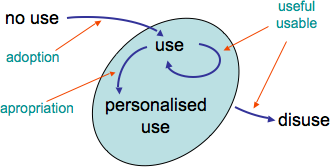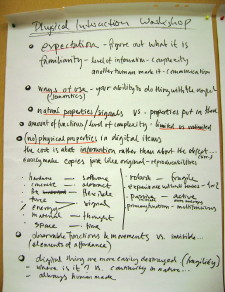A few weeks ago I had a short visit to Berlin as a guest of Prometei, a PhD training program at the University of Technology of Berlin focused on “prospective engineering of human-technology-interaction”. While there I gave an evening talk on “Designing for adoption and designing for appropriation” and spent a very pleasant afternoon seminar with the students on “Physicality and Interaction”.
I said I would send some links, so this is both a short report on the visit and also a few links to appropriation and adoption and a big long list of links to physicality!
Evening talk: Designing for adoption and designing for appropriation
I started1 with my three use words: useful, usable and used … it doesn’t matter if your design is the most perfect ever, if it is never actually used it is useless! The talk centred around the dynamics of use:

adoption – the path between no use and use
appropriation – from plain use to the artefact becoming deeply embedded in the user’s life
In the questions I was asked how my useful-usable-used, differed from useful-usable-desirable, which is used in some ‘design’ texts. I would say that desirable is just one of the things that makes something used, in addition there are things like organisational acceptability, availability, … not to mention cost! However, the question, and subsequent talk after dinner, reminded me that I have very little knowledge of the ‘design’ literature2.
The appropriation part of the talk was largely based on my HCI2007 short paper “designing for appropriation“. See also blogs about the topic by Palojono and Dan Perkel.
The adoption part was based on a draft section on designing for adoption (for next edition of HCI book) and draws heavily on my experiences in the dot.com days on 1998-2000. During that time I wrote a number of eBusiness bulletins covering various aspects of internet product development and marketing; partiicularly relevent for this talk are bulletins about lattice of value, marketplace ecology, network effects, and the websharer vision.
Some of the analysis is based on Grudin’s critical mass arguments for CSCW systems, but it was in Andy Cockburn‘s thesis that I first saw this being used as a positive design tool.
 During the talk I passed round some of the little Firefly units that we have developed at Lancaster that are still on display in Lancaster city centre (see blog entry).
During the talk I passed round some of the little Firefly units that we have developed at Lancaster that are still on display in Lancaster city centre (see blog entry).
PhD workshop on physicality
I really enjoyed the afternoon with the Prometei students. I asked them to bring things with them natural and man-made3, which we used as props in the discussion during the afternoon.
Everyone had two minutes to write down some differences between different kinds of things on the natural/artificial and physical/digital spectrum:
(i) natural – such as rock, wood, etc., (but not animal)
(ii) man made but simple – such as hammers or spoons
(iii) mechanical – some hand-powered such as a hand-drill, some electrically powered such as a small food mixer
(iv) digital products – such as phones, PDAs, etc.
We then spent the rest of the three hour session simply discussing what was written down – the time seemed to fly by. The flipchart notes try to reduce each element down to a single word or short phrase, but can not do justice to the rich discussion around each item.
One thing I found fascinating was that, while there was overlap between the issues raised by different people, there was also a huge difference in the kinds of issues that different people considered. The very first points on the flip chart were all about prior expectations and focused on the experiential aspects of physical and digital devices. This contrasted with my own first thoughts and that of some others in the group, which tended to be about physical properties. Interestingly several of the ‘techie’ artefacts that people brought had their own personal stories, such as Habakuk’s binocular that belonged to his grandfather. … but I don’t recall any such stories about the purely digital artefacts. Interestingly the binocular was I guess at least 40 years old but still functioned well, a 4 year old digital device is completely out of date!
Several people mentioned the relative fragility of digital devices. This is partly because of the materials used to make them (often plastic), but also because with a digital or mechanical object it is the relative configuration of parts that matter as much as the parts themselves. Hit a stone hard enough and you get two stones, but take a computer to bits and you get … just bits.
My daughter once gave me some stones for my birthday. At first they looked just like a collection of pretty grey pebbles with streaks of white through them. Then I recognised an ‘A’ on one of them, and then that they were, in fact, all the letters of my name. The stones themselves were natural, but when suitable selected and put in the right relation to one another they were a word.

In Doc Hollywood when the local garage rebuilds his precious car they give him a part “there’s always one bit left over” they say … of course the joke is that with a car if you leave one bit out it usually doesn’t run. However, with a tree if you chop one branch off it is still a tree, or take one grain from the Sahara and it is still dessert. With complexity comes fragility.
With many of the aspects that came up there were often contradictions. Although digital devices were regarded as fragile, digital information was the opposite. It is not bound by particular materials, but can be captured and replicated in the configurations of different materials at different places and times (from text on a page to electrons in circuits, or magnetised particles on a spinning disc surface).
We covered many topics (look a the enlarged flipchart image to see) some more physical (e.g. physical has size, digital virtually no size), some about interaction (e.g. affordance related ability to immediately ascertain how to manipulate a physical object vs. instruction manual for complex devices), and some communicative (continued sense of the creator, physical sign vs digital symbol).
As the evening talk was to be abut affordance, it was interesting that several people picked up on the ability to use physical items including less complex man-made ones in new ways, whereas digital devices tended to be used as designed. However, this was contrasted with the fact that in other ways a digital device (in principle) are able to be reconfigured and repurposed.
Later on, Habakuk told me about a list of aspects of physical/digital differences they they made for a TEI conference session, that they label PIBA (Physicality is Better At) vs DIBA (Digitality is Better At) [see list]. Also he and others are organising a SIG at CHI on “Designing for Intuitive Use“.
Physicality some of my own writing
I said that I would distribute a list of things I’ve done related to physicality. So including it here. Just a list I’m afraid … maybe something more annotated at another time …
- www.physicality.org – for info on DEPtH project, proceedings of Physicality 2006 & Physicality 2007 worhshops, and upcoming workshops
- First Steps in Physicality – preface to Physicality 2006 has breakdown of different physicality issues
- various keynotes and talks including: Physicality, rationality and imagination, and driving as a cyborg experience.
- my blog entries on physicality: especially physicality and middle ages tech support and matterealities and the physical embodiment of code.
- work with Masitah and others on natural interaction and fluidity: Aladdin’s lamp: understanding new from old, Knowledge of Today for the Design of Tomorrow, Visceral Interaction, Natural Inverse: Physicality, Interaction and Meaning,
- more formal approaches: Modelling Devices for Natural Interaction, Formalising Performative Interaction, and loads on status-event analysis.
- about paper documents and related: Finding Decisions Through Artefacts, Artefact-centred analysis – transect and archaeological approaches, Accidents of Infornation.
- about the physical nature of space: Welsh Mathematician walks in Cyberspace (the cartography of cyberspace), Exploiting space and location as a design framework for interactive mobile systems, Managing multiple spaces (also as book chapter), The auditability of public space – approaching security through social visibility, Paths and Patches – patterns of geognosy and gnosis.
- Well to be strictly honest I started talking about the graffiti in the toilets … which did relate to appropriation: the toilet walls can be appropriated for graffiti precisely because they do not serve a function. I mentioned the Viking graffiti at Maes Howe in Orkney, which is remarkable similar in content to its modern equivalent. [back]
- ‘design’ in quotes as the word is used in many ways and by this I sort of mean mainly product design.[back]
- and we even had a short discussion about gendered language where the men told me that it wasn’t an issue in German and the women said the opposite![back]
